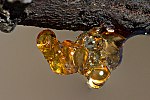Exudate
An exudate is a fluid released by an organism through pores or a wound, a process known as exuding or exudation.[1] Exudate is derived from exude 'to ooze'
Medicine
An exudate is any fluid that filters from the circulatory system into lesions or areas of inflammation. It can be a pus-like or clear fluid. When an injury occurs, leaving skin exposed, it leaks out of the blood vessels and into nearby tissues. The fluid is composed of serum, fibrin, and leukocytes. Exudate may ooze from cuts or from areas of infection or inflammation.[4]
Types
| Transudate vs. exudate | ||
|---|---|---|
| Transudate | Exudate | |
| Main causes | ↑ colloid
osmotic pressure |
Inflammation-Increased vascular permeability |
| Appearance | Clear[5] | Cloudy[5] |
Specific gravity |
< 1.012 |
> 1.020
|
| Protein content | < 2.5 g/dL |
> 2.9 g/dL[6]
|
| fluid protein/ serum protein |
< 0.5 | > 0.5[7] |
| SAAG = Serum [albumin] - Effusion [albumin] |
> 1.2 g/dL | < 1.2 g/dL[8] |
| fluid LDH upper limit for serum |
< 0.6 or < 2⁄3 | > 0.6[6] or > 2⁄3[7] |
| Cholesterol content | < 45 mg/dL | > 45 |
| Radiodensity on CT scan | 2 to 15 HU[9] | 4 to 33 HU[9] |
- Purulent or suppurative exudate consists of plasma with both active and dead parenchymal cells. This kind of exudate is consistent with more severe infections, and is commonly referred to as pus.
- Fibrinous exudate is composed mainly of strep throat and bacterial pneumonia. Fibrinous inflammation is often difficult to resolve due to blood vessels growing into the exudate and filling space that was occupied by fibrin. Often, large amounts of antibiotics are necessary for resolution.
- Catarrhal exudate is seen in the nose and throat and is characterized by a high content of mucus.
- Serous exudate (sometimes classified as serous transudate) is usually seen in mild inflammation, with relatively low protein.[10] Its consistency resembles that of serum, and can usually be seen in certain disease states like tuberculosis. (See below for difference between transudate and exudate)
- Malignant (or cancerous) pleural effusion is effusion where cancer cells are present.[11] It is usually classified as exudate.
Types of exudates: serous, serosanguineous, sanguineous, hemorrhaging and purulent drainage.
- Serous: Clear straw colored liquid that drains from the wound. This is a normal part of the healing process.
- Serosanguineous: Small amount of blood is present in the drainage; it is pink in color due to the presence of red blood cells mixed with serous drainage. This is a normal part of the healing process.
- Sanguineous: This type of drainage contains red blood due to trauma of blood vessels, this may occur while cleaning the wound. Sanguineous drainage is abnormal.
- Hemorrhaging: This type of drainage contains frank blood from a leaking blood vessel. This will require emergency treatment to control the bleed. This type of drainage is abnormal.
- Purulent drainage: This type of drainage is malodorous and can be yellow, gray, or greenish in color. This is an indication of an infection.
Exudates vs. transudates
There is an important distinction between
specific gravity of extracted fluid. Specific gravity is used to measure the protein content of the fluid. The higher the specific gravity, the greater the likelihood of capillary permeability changes in relation to body cavities. For example, the specific gravity of the transudate is usually less than 1.012 and a protein content of less than 2 g/100 mL (2 g%). Rivalta test
may be used to differentiate an exudate from a transudate.
It is not clear if there is a distinction in the difference of transudates and exudates in plants.
Plant exudates
Plant exudates include
See also
- Guttation
- Pleural effusion
- Scarless wound healing
- Surfactant leaching
References
- ^ "exudate". The Free Dictionary - Medical. Retrieved 5 August 2014.
- Merriam Webster. 2008. Retrieved 2008-07-04.
- ISBN 0-550-14230-4.
- ^ "Exudate". MedlinePlus.
- ^ a b The University of Utah • Spencer S. Eccles Health Sciences Library > WebPath images > "Inflammation".
- ^ PMID 9106577.
- ^ PMID 4642731.
- PMID 2152757.
- ^ PMID 24100060.
- ^ Robbins Basic Pathology 7th ed
- ^ About.com > Malignant Pleural Effusion Archived 2012-02-26 at the Wayback Machine By Lynne Eldridge MD. Updated March 27, 2010
- ISBN 9781441966612. Retrieved 2 October 2012.
- S2CID 42515027.
- ISBN 0124735436.
- PMID 12746510.
- PMID 29375501.
External links
 Media related to Exudate at Wikimedia Commons
Media related to Exudate at Wikimedia Commons


